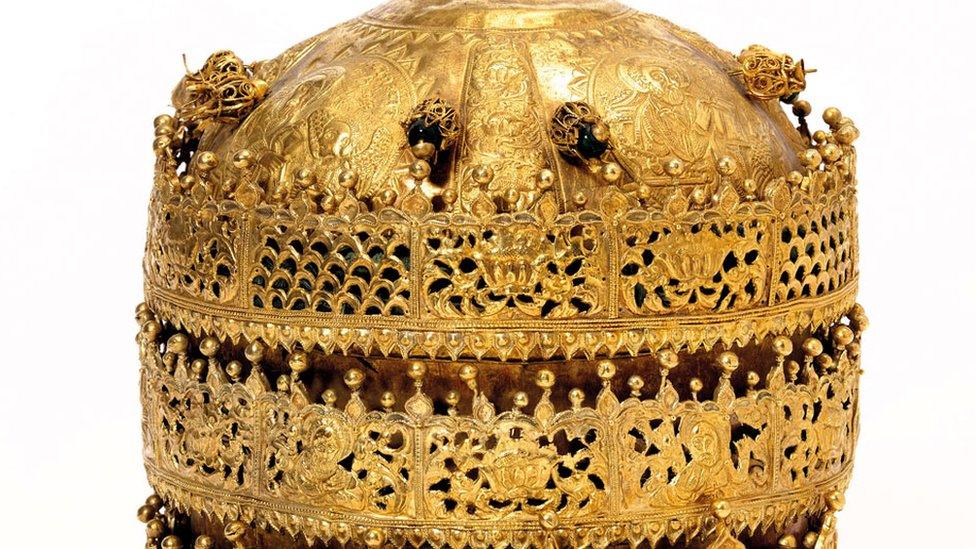What do you know about Africa's 'looted treasures'?
- Published
During colonial rule in Africa, thousands of cultural artefacts were seized from the continent by western countries. But now, France has launched a report, external calling for thousands of African artefacts in its museums to be returned to the continent. This comes as major museums across Europe have agreed to loan key artefacts back to Nigeria, external.
What do you know about Africa’s 'looted treasures'?
Question 1/6
The Rosetta Stone was the key to unlocking the lost hieroglyphic script of ancient Egypt. But who discovered the mighty slab (750kg), now held in the British Museum, in 1799?
Question 1/6
The generally accepted story is that French soldiers found the stone while digging the foundations of a fort on the Nile Delta.

Question 2/6
British forces seized Ethiopian treasures at the Battle of Maqdala in 1868. But how many elephants did they use to carry off the loot?
Question 2/6
Fifteen elephants and 200 mules were needed to transport treasures looted at Maqdala. These included a golden crown, chalices and early Christian manuscripts still held at various British institutions

Question 3/6
Who were the man-eaters of Tsavo?
Question 3/6
Two lions from Kenya’s Tsavo region killed 35 labourers building a colonial-era railway. They were shot in 1898 by a British engineer. Their stuffed remains are in a US museum.

Question 4/6
A soapstone sculpture of a fish eagle is Zimbabwe's main national emblem. Eight of the Zimbabwe Birds were looted from the ruins of an ancient city - how many have been returned?
Question 4/6
Seven of the carvings are in Zimbabwe since 2003, when the bottom section of one was returned by Germany. The eighth remains in the old bedroom of 19th Century British imperialist Cecil Rhodes, whose home in the South African city of Cape Town is now a museum.

Question 5/6
The renowned Bangwa Queen wooden sculpture was taken from what is now Cameroon at the end of the 19th Century. Locals referred to the female figure as “njuindem”. Meaning what?
Question 5/6
"Njuindem" means "woman of God" in the language of the Bangwa people. Now owned by the Dapper Foundation in Paris, France after Musée Dapper closed in 2017, mystery surrounds the sculpture’s acquisition by German colonial agent Gustav Conrau in 1899.

Question 6/6
What are the Benin Bronzes mainly made out of?
Question 6/6
Looted by British troops in 1897, the Benin Bronzes are mainly made from brass. Most remain in museums in the UK, Germany and US.





Credits: Development: William Muli, Design: Millicent Wachira, Animation: George Wafula, Research & Writing: Ashley Lime, Producer: Hugo Williams & Muthoni Muchiri.
What do you know about Africa’s 'looted treasures'?

Question 1/6
Country: Egypt
The Rosetta Stone was the key to unlocking the lost hieroglyphic script of ancient Egypt. But who discovered the mighty slab (750kg), now held in the British Museum, in 1799?
- 1. An Egyptian fisherman
- 2. British archaeologists
- 3. French troops under Napoleon
Correct Answer
The generally accepted story is that French soldiers found the stone while digging the foundations of a fort on the Nile Delta.

Question 2/6
Country: Ethiopia
British forces seized Ethiopian treasures at the Battle of Maqdala in 1868. But how many elephants did they use to carry off the loot?
- 1. 0
- 2. 15
- 3. 3
Correct Answer
Fifteen elephants and 200 mules were needed to transport treasures looted at Maqdala. These included a golden crown, chalices and early Christian manuscripts still held at various British institutions

Question 3/6
Country: Kenya
Who were the man-eaters of Tsavo?
- 1. Corrupt officials in Kenya
- 2. Polygamous women
- 3. A pair of man-eating lions
Correct Answer
Two lions from Kenya’s Tsavo region killed 35 labourers building a colonial-era railway. They were shot in 1898 by a British engineer. Their stuffed remains are in a US museum.

Question 4/6
Country: Zimbabwe
A soapstone sculpture of a fish eagle is Zimbabwe's main national emblem. Eight of the Zimbabwe Birds were looted from the ruins of an ancient city - how many have been returned?
- 1. 7
- 2. 0
- 3. 1
Correct Answer
Seven of the carvings are in Zimbabwe since 2003, when the bottom section of one was returned by Germany. The eighth remains in the old bedroom of 19th Century British imperialist Cecil Rhodes, whose home in the South African city of Cape Town is now a museum.

Question 5/6
Country: Cameroon
The renowned Bangwa Queen wooden sculpture was taken from what is now Cameroon at the end of the 19th Century. Locals referred to the female figure as “njuindem”. Meaning what?
- 1. Woman of God
- 2. Great warrior
- 3. Happy mother
Correct Answer
"Njuindem" means "woman of God" in the language of the Bangwa people. Now owned by the Dapper Foundation in Paris, France after Musée Dapper closed in 2017, mystery surrounds the sculpture’s acquisition by German colonial agent Gustav Conrau in 1899.

Question 6/6
Country: Benin
What are the Benin Bronzes mainly made out of?
- 1. Brass
- 2. Stone
- 3. Bronze
Correct Answer
Looted by British troops in 1897, the Benin Bronzes are mainly made from brass. Most remain in museums in the UK, Germany and US.

Learn more
- Published23 November 2018
